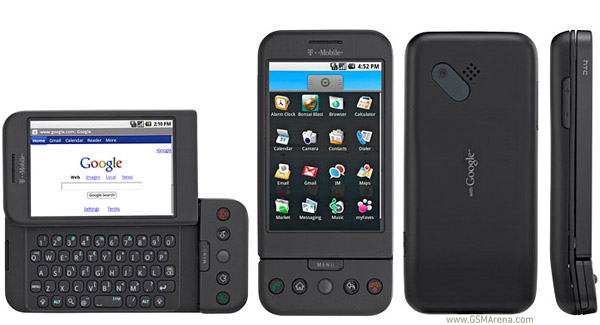
Would you buy a cell phone if it was really, really, really cool, and could help organize your life, and had web connectivity and GPS and all sorts of other neat stuff, but couldn’t make calls inside your house because of service problems?
Oh — you wouldn’t? Well, screw you, no one cares what you think anyway!
Well, I did it — I went and bought a G1. If you don’t know what a G1 is, it’s Google’s first foray in to the world of cellular telephones — a cell phone, made by a company called HTC, running Google’s Android mobile phone operating system.
It really is a great phone — more like a tiny computer. It links up and syncs completely with your Google account (a great boon for disorganized people like myself — now my cell phone, which is with me always, can remind me of things I set on my computer, which is not with me always).
It has built-in WIFI access, built-in GPS, and to top it all off, the entire thing is running on top of a Linux installation (that you can hack the shit out of if you want to).
That being said, there are certain… issues with the G1.
Number one:Â the battery life, or lack thereof. And this isn’t just the usual “Oh, my battery doesn’t last for 15 days, therefore it stinks.” No, no, no. I can fully charge my G1, let it sit there, maybe browse the net a few times, poke around here and there, and 22 hours later it’s dead. And this isn’t even with me even really doing anything on the phone. I’m just practically letting it sit there.
In converse, Nina can sit there with her Blackberry Curve browsing the net, sending SMS, Twittering, and her battery lasts for about three days.
Of course — I can live with that. It’s a powerful device — it needs a lot of power. It’s like a small computer, like I said — if I had a laptop with a battery that lasted for 22 hours, I’d be really happy!
However, here’s the practical dealbreaker — the G1 has no UMA. What’s that, you may ask? It’s a technology that allows (modern) cell phones to make calls over your home’s WIFI internet, using your regular cell phone minutes — it’s kinda of like having a super-strong cell phone tower in your house, with unlimited reception.
Never a dropped call, crystal clear connection — it’s amazing.
More importantly, if you live in an area with poor cell phone reception (say, you can receive calls outside your house but not inside, or you’re roaming inside your house, or whatever), UMA pretty much fixes that. And it’s seamless, too — you can make a call inside your house, go outside, and it doesn’t get dropped, and vice-versa.
The G1 not having this, in the area where we live, makes it almost useless inside our home (where I’m spending most of our time if I’m not at work, and thus too busy to use my phone).
Sigh.
(Still deciding what to do about this.)
 World War Z: An Oral History of the Zombie War by Max Brooks
World War Z: An Oral History of the Zombie War by Max Brooks Well, I got tired of being stuck with the version 2.4 of the GIMP (GNU Image Manipulation Program) that ships with Ubuntu 8.04. It’s old, it uses the old window system that I can’t stand anymore, and version 2.6 (the current version) fixes tons of more issues that it has.
Well, I got tired of being stuck with the version 2.4 of the GIMP (GNU Image Manipulation Program) that ships with Ubuntu 8.04. It’s old, it uses the old window system that I can’t stand anymore, and version 2.6 (the current version) fixes tons of more issues that it has.
